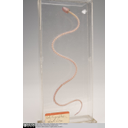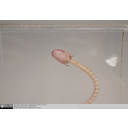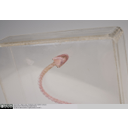Caecilians
The caecilians are a
group of limbless, burrowing amphibians, which superficially resemble
earthworms or some limbless lizards (snakes, amphisbaenians). Together,
caecilians form the order Gymnophiona - one of the three extant amphibian
orders, along with Anura (frogs and toads) and Caudata (newts and salamanders).
Diversity and Lower Taxonomy:
The Gymnophiona currently comprises 183 extant species
of caecilian. Until recently, these were grouped between the following six
families: Caecilidae,
Ichthyophiidae, Rhinatrematidae, Scolecomorphidae, Typhlonectidae, and
Uraeotyphlidae. However, in 2006, Frost et al. revised amphibian phylogeny,
proposing that only three of the previous six caecilian familial groupings - Caecilidae, Ichthyophiidae, and
Rhinatrematidae - represented
distinct families. The remaining three groupings are now thought to be embedded
within these three major lineages, with caecilian taxonomy as follows:
- Caecilidae - 123 species
- 21 genera including 104 species
- Scolecomorphinae (6 species in
2 genera)
- Typhlonectinae (13 species in
5 genera)
- 21 genera including 104 species
- Ichthyophiidae - 50 species in
3 genera (including the genus Uraeotyphlus)
- Rhinatrematidae - 10 species in
2 genera
Distribution and
Habitat:
Most
caecilians inhabit moist tropical and subtropical regions of South and Central
America, South and
Almost
all caecilians are terrestrial, but they are elusive as they spend the majority
of their lives underground. They burrow primarily
in forests, but also in grassland, savanna, shrubland, and wetlands.
Members
of the suborder Typhlonectinae are known as aquatic caecilians, and inhabit
freshwater systems. At least four typhlonectin species are exclusively aquatic.
Conservation Status (IUCN):
Of
the 172 species of caecilian present on the IUCN Red List, over 66% (114
species) are lacking enough data to have their extinction threat assessed (Data
Deficient).
For
the 58 species for which there is sufficient data for assessment, 52 are
considered ofLeast Concern. The remaining 6 species are threatened with
extinction, with fourVulnerable, one Endangered (Grandisonia brevis), and one Critically Endangered(Boulengerula
niedeni).
Features:
- No appendicular skeleton -
they are completely limbless and have no shoulder girdle, but there
is a kink in the spine where the pelvic girdle once was.
- 95-285 presacral vertebrae (those anterior to
the sacral vertebrae, which once fused with
the pelvic girdle).
- Compound, akinetic skull formed
of joined plates of bone - this is an excellent and typical
adaptation for a fossorial animal (also seen
in burrowing lizards, and burrowing mammals, such as the golden moles),
allowing the head to be used like a spade to dig, push, and pack earth
when burrowing in underground tunnels.
- Reduced eyes.
- 200+ lymph hearts situated
intersegmentally under the skin.
Licensed under the Creative Commons Attribution Non-commercial Share Alike 3.0 License
'Vertebrate Diversity' has been released as an open educational resource (OER) on a Creative Commons 'Attribution Non-commercial Share Alike' license. This means that once downloaded, content can be modified and improved to complement a particular course. This requires, however, that improvements are recycled back into the OER community. All content present at the time of download must be accordingly credited and, in turn, novel content must be appropriately licensed. For more information, please refer to the license deed by clicking on the link above.


